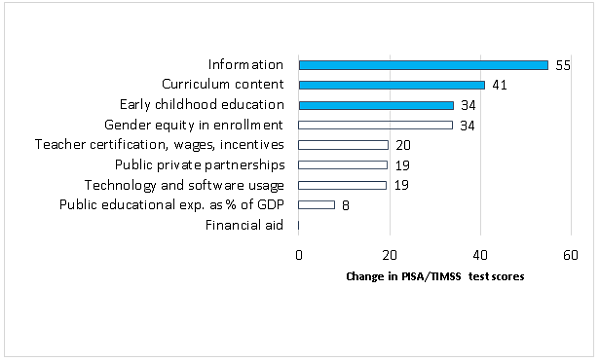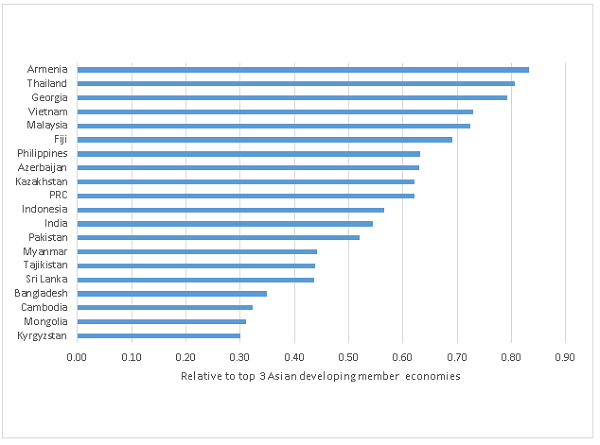Improving education outcomes has perplexed reformers for decades. The typical solution has been to throw more money at the problem. However, instead of improving education outcomes, the money has often entrenched poor practices within inflexible public systems. A major reason why money for education has not translated into better outcomes is that it has gone to reform initiatives that have often been guided by ideology and preconceived biases rather than rigorous evidence of what works and what doesn’t.
In recent years, both education specialists and economists have begun looking for more evidence-based solutions.
Here at the Asian Development Bank (ADB), we started last year to undertake an educational benchmarking exercise to better identify and evaluate the critical components of a country’s educational system. Covering over 250 indicators related to skills development and basic education, data were compiled for 67 countries globally where students have taken internationally comparable standardized tests to help identify which types of investments in education might be more effective independent of the country context.
Our initial results (published in ADB’s Key Indicators) provide suggestive evidence that more than any other indicator, countries where both parents and students have access to quality information about student learning outcomes and school quality have higher average skills at age 15 (Figure 1). These investments were neither explained by a country’s income nor educational attainment of those aged 15-65.
Notably, greater educational financing (as a percentage of GDP) was not a significant predictor of improved skills. While this educational benchmarking exercise is only a start, it tends to underscore that financing alone is unlikely to help countries deliver better skills.
Figure 1: Moving education indicator from bottom three to top three Asian developing member economies

Notes: (1) Top three Asian developing member economies are Singapore; Taipei, China; Republic of Korea. (2) Information is comprised of Data for Evidence-based Policy Decisions (National) and Information for Basic and Upper Secondary Education (3) Solid columns are those that are significant at 10 percent level at least eight out of 15 times. Exp. = expenditures. Estimates based on cross-country regression of education benchmarking indicators on average PISA test scores controlling for years of schooling of working population age 15-65 and GDP per capita.
Source: ADB estimates.
Getting more from investments
If information is key, how can school systems improve the collection and dissemination of information and, more critically, its usage in developing better policies? This feedback loop can allow governments to better allocate resources and make investment decisions in education based on hard evidence, including more effectively managing schools and teachers.
To start, this means that school systems should collect detailed data on educational inputs and outcomes. Important inputs include information on school infrastructure; materials; teacher skills, certifications, and indicators of prior classroom performance. Outcomes should consist of not only data on educational attainment (like pass rates, degrees, or years in school), but standardized assessments of critical cognitive, non-cognitive, and technical skills.
Our analysis demonstrates that it is not enough for countries to simply collect data—it must also be shared publicly. This means data should be simple to understand and meaningful, so that it can help an average individual or family make better decisions—like where to send their child to school or what degree program offers the best chances of finding a good job. It can also help motivate parents to support their child’s learning through additional tutoring or studies. The upshot is that this same information is likely to hold schools and teachers more accountable for student outcomes when this information reflects teacher and schools actual contribution to learning outcomes.
In developing Asia, where 23 of the countries studied are located and where ADB works with governments on education reform, many countries continue to have large gaps in their information and data collection practices with the best performing Asian economies (Figure 2). This is despite these economies having public expenditures on education amounting to more than $1.1 trillion in 2012 alone.
Skeptics may validly question whether it is possible to collect detailed information on education in developing countries that lack good governance or capacity. Credible information gathering has historically been a tedious process, requiring a well-functioning bureaucracy that can ensure the credibility, validity, and compliance of data collection. Today, however, technology is revolutionizing how information is collected, managed, analyzed, and shared. Even remote areas with limited resources are able to track results more quickly and efficiently than ever before as the cost of management information systems (MIS) is in constant decline.
The reality is that money is no longer a binding constraint for governments to collect and disseminate quality information on education and skills development. Take for example Afghanistan, which has used MIS systems to develop programs to more effectively target teachers for different training and professional development; monitor the operation and maintenance of infrastructure assets; and track student performance. Pakistan has used their educational MIS system to feed them into local school service action plans to identify poor performing schools and better ensure that the information is translated into actual changes in education provision.
Figure 2: Information collection practices by country

Notes: (1) Top 3 Asian developing member economies are Singapore; Taipei, China; Republic of Korea. (2) Information is comprised of Data for Evidence-based policy decisions (National) and information for basic and upper secondary education.
Source: Estimates based on benchmarking exercise.
Prioritizing information
Prioritizing information is the necessary first step toward building more effective education systems. Without this commitment, more money may not deliver much in terms of better results. This is why the evidence has found that programs receiving a large share of investments such as teacher training, capacity building, and investments poured into model schools with better infrastructure, teachers, and materials have not always translated into better skills.
Information, driven by data, does not yet have the same cache for governments or investors, who are impatient for results or for cutting a red-ribbon of a newly minted school. Yet, data are essential to more broad-based and relevant skill development. Education reforms should be dedicated to decisions driven by evidence. This means ensuring that facts, rather than fiction and feel-good stories of experiences, determine educational investments.
The Brookings Institution is committed to quality, independence, and impact.
We are supported by a diverse array of funders. In line with our values and policies, each Brookings publication represents the sole views of its author(s).




Commentary
Information, not money, is the key to improving education
April 7, 2016